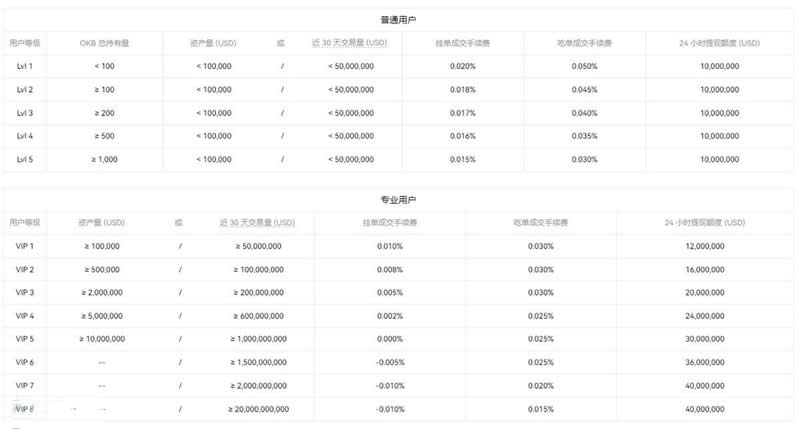 web3.0
web3.0
 Is there a big difference in the handling fees between isolated position and cross position in the currency circle? What are their handling fees?
Is there a big difference in the handling fees between isolated position and cross position in the currency circle? What are their handling fees?
Is there a big difference in the handling fees between isolated position and cross position in the currency circle? What are their handling fees?
php editor Yuzai is here to answer the question of handling fees for isolated positions and full positions in the currency circle. In currency trading, isolated position and cross position are two different trading modes. Isolated position refers to trading according to the leverage multiple set by yourself. Only the funds used in the current transaction are calculated, and the handling fee is generally low. Cross position uses all available funds as trading margin, and the handling fee is generally higher. The specific handling fee needs to be determined according to different trading platforms and trading types. It is recommended to consult the rate table of the relevant platform to obtain accurate information before conducting transactions.

Which fee is higher, isolated position or full position?
The handling fee charging standards for isolated position and cross position trading are the same, but the handling fee models for U-based contracts and currency-based contracts are different. Isolated position trading can provide higher leverage, but the risk is greater; cross position trading is more stable. Investors should choose a suitable trading method based on their own trading needs.
In the isolated position mode, investors only need to provide the margin required to open a position, but do not have to provide the total margin required for the entire position. This means that for the same position, the initial margin in isolated position mode is smaller. However, if a loss on a position results in insufficient margin, a forced liquidation may be triggered.
In the cross position mode, investors need to provide the total margin required for the entire position to maintain the stability of their positions. However, since the cross margin model requires more margin, the initial margin requirement is higher.
What are the handling fees for isolated position and cross position respectively?
According to OKX official information disclosure, the handling fees for isolated positions and cross positions are divided into two levels, ranging from 0.010% to 0.050% respectively. Users are graded based on their holdings or trading volume and asset volume. The level of ordinary users is determined by their OKB holdings, while the level of professional users is determined by their trading volume and asset volume. A user's level determines their transaction fees on the next trading day.
When calculating the handling fee level, users will determine the handling fee level based on currency trading volume, total perpetual and delivery contract trading volume, option contract trading volume, spread strategy trading volume and asset volume. If the conditions of different levels are met, users will enjoy the highest level of handling fee discounts.
For example, a user’s currency trading volume in the last 30 days is 10,000,000USD (meeting VIP2), and the total trading volume of perpetual and delivery contracts in the last 30 days (USDT perpetual contract, USDT delivery contract, USDC perpetual contract , USDC delivery contract, coin-margined perpetual contract and coin-margined delivery contract) is 200,000,000USD (meeting VIP3), the option trading volume in the last 30 days is 5,000,000USD (meeting VIP1), and the spread strategy trading volume in the last 30 days is 150,000,000USD (meeting VIP1) VIP2), if the snapshot asset amount at 0:00 on the day is 5,000,000USD (satisfying VIP4), then the handling fee level enjoyed by this user is VIP4, and all business line transactions can enjoy the preferential conditions of VIP4.

USDT delivery, USDC perpetual and USDC delivery contracts:
Fee calculation formula: USDT delivery, USDC perpetual and USDC delivery contract fees = Handling fee rate USDC is settled and collected when the actual transaction is completed. Take the BTCUSDC perpetual contract (contract face value is 0.0001 BTC, contract multiplier is 1) as an example. Assume that the current price of BTC is 20,000 USDC; Trader A (fee level is Lvl1) uses 2,000 USDC (0.1 BTC) as a margin. Buy (or sell) 100 contracts (0.01BTC) at the market price with 10 times leverage, and be the taker when the transaction is completed. The handling fee to be paid = 0.05% × (100 × 1 × 0.0001 × 20,000) = 0.1USDC; trader A uses 2,000 USDC (0.1 BTC) as margin, buys (or sells) 100 contracts (0.01 BTC) with 10 times leverage limit price, and is the placing order when the transaction is completed. The handling fee to be paid = 0.02% × (100 ×1×0.0001×20,000)=0.04USDC.
Coin-based perpetual and currency-standard delivery contracts:
Handling fee calculation formula: Coin-based perpetual and delivery contract handling fees = handling rate × (number of transactions × contract multiplier × Contract face value/transaction price).
Handling fee collection rules: Coin-based perpetual and delivery contract handling fees are settled in the transaction currency and are collected when the actual transaction is completed. Take the BTCUSD perpetual contract (the contract face value is 100USD, the contract multiplier is 1) as an example, assuming that the current price of BTC is 20,000USD; Trader A (fee level is Lvl1) uses 0.05BTC (1,000USD) as a margin, and Buy (or sell) 100 contracts (10,000USD) at the market price with 10 times leverage. The taker is the taker when the transaction is completed. The handling fee to be paid = 0.05% × (100 × 1 × 100/20,000) = 0.00025 BTC; Trader A Use 0.05BTC (1,000USD) as a margin, buy (or sell) 100 contracts (10,000USD) with a 10x leverage limit, and be the placing order when the transaction is completed. The handling fee to be paid = 0.02% × (100 × 1×100/20,000)=0.0001BTC.
Delivery handling fee collection rules: uniformly charged at 0.01%, not affected by the handling fee level.
Forced liquidation fee collection rules: Charge according to the taker rate of the user's current level.
The above is the detailed content of Is there a big difference in the handling fees between isolated position and cross position in the currency circle? What are their handling fees?. For more information, please follow other related articles on the PHP Chinese website!

Hot AI Tools

Undresser.AI Undress
AI-powered app for creating realistic nude photos

AI Clothes Remover
Online AI tool for removing clothes from photos.

Undress AI Tool
Undress images for free

Clothoff.io
AI clothes remover

AI Hentai Generator
Generate AI Hentai for free.

Hot Article

Hot Tools

Notepad++7.3.1
Easy-to-use and free code editor

SublimeText3 Chinese version
Chinese version, very easy to use

Zend Studio 13.0.1
Powerful PHP integrated development environment

Dreamweaver CS6
Visual web development tools

SublimeText3 Mac version
God-level code editing software (SublimeText3)

Hot Topics
 1371
1371
 52
52
 Qubetics ($TICS): The Revolutionizing AI Crypto
Mar 23, 2025 am 10:08 AM
Qubetics ($TICS): The Revolutionizing AI Crypto
Mar 23, 2025 am 10:08 AM
Cryptocurrency has always been a realm where the cutting edge of technology meets bold ambition, and it's only getting more exciting in the future. As artificial intelligence continues to grow in influence, there are a handful of digital assets that
 Bitcoin historical price list 2015-2025 Bitcoin price trend charts in the past decade
Mar 12, 2025 pm 06:54 PM
Bitcoin historical price list 2015-2025 Bitcoin price trend charts in the past decade
Mar 12, 2025 pm 06:54 PM
This article reviews the ten-year price trend of Bitcoin from 2015 to 2025 in detail. Data shows that Bitcoin price fluctuates dramatically, experiencing huge changes from $200 to over $100,000. During this period, the price of Bitcoin was affected by a variety of factors, including halving of block rewards, market sentiment, regulatory policies, and global macroeconomic situation. The article analyzes the rise and fall of Bitcoin prices year by year, and focuses on interpreting the price changes in key years, providing a reference for investors to understand the history of Bitcoin prices and predict future trends. Keywords: Bitcoin price, Bitcoin trend, Bitcoin decade, digital currency, cryptocurrency
![Bitcoin [BTC] was on a downtrend after losing the $92,000-support level in the final week of February](https://img.php.cn/upload/article/001/246/273/174209101774967.jpg?x-oss-process=image/resize,m_fill,h_207,w_330) Bitcoin [BTC] was on a downtrend after losing the $92,000-support level in the final week of February
Mar 16, 2025 am 10:10 AM
Bitcoin [BTC] was on a downtrend after losing the $92,000-support level in the final week of February
Mar 16, 2025 am 10:10 AM
Technical indicators such as the OBV showed that selling pressure has been dominant, meaning more losses may be likely ahead.
 Top 10 Free Virtual Currency Exchanges Rankings The latest top ten virtual currency APP trading platforms
Mar 11, 2025 am 10:18 AM
Top 10 Free Virtual Currency Exchanges Rankings The latest top ten virtual currency APP trading platforms
Mar 11, 2025 am 10:18 AM
The top ten free virtual currency exchanges are ranked: 1. OKX; 2. Binance; 3. Gate.io; 4. Huobi Global; 5. Kraken; 6. Coinbase; 7. KuCoin; 8. Crypto.com; 9. MEXC Global; 10. Bitfinex. These platforms each have their own advantages.
 Ethereum historical price trend chart 2015-2024 Ethereum k-line chart ten years trend trend
Mar 12, 2025 pm 06:57 PM
Ethereum historical price trend chart 2015-2024 Ethereum k-line chart ten years trend trend
Mar 12, 2025 pm 06:57 PM
This article reviews the price trend of Ethereum since its listing in 2015, from the initial $0.31, it experienced a surge in 2017 to nearly $1,400, as well as a market plunge in 2018 and 2022, and then hit a record high of $4,891.70 in 2021, as well as a rebound and stability in 2023. The article data covers the significant changes in Ethereum prices over each year and predicts price trends for 2024-2025, providing investors with a comprehensive historical reference and future outlook for Ethereum prices. Understand the history of Ethereum price fluctuations and seize investment opportunities!
 Cyber criminals were able to steal cryptocurrency worth 1.5 billion US dollars
Mar 16, 2025 am 11:12 AM
Cyber criminals were able to steal cryptocurrency worth 1.5 billion US dollars
Mar 16, 2025 am 11:12 AM
Since then, the provider has been investigating how this could have happened and how it will (hopefully) not happen again in the future.
 Top 10 digital currency app platforms rankings Virtual currency exchange latest rankings in 2025
Mar 13, 2025 pm 06:45 PM
Top 10 digital currency app platforms rankings Virtual currency exchange latest rankings in 2025
Mar 13, 2025 pm 06:45 PM
Top 10 digital currency app platforms: 1. OKX, 2. Binance, 3. Gate.io, 4. Kraken, 5. Coinbase, 6. Huobi, 7. KuCoin, 8. Crypto.com, 9. Bitfinex, 10. Gemini; these platforms are ranked according to factors such as transaction volume, security and user experience. When choosing, the platform's security, liquidity, transaction fees, currency selection, user interface and customer support should be considered.
 okx Ouyi Exchange web version enter link click to enter
Mar 31, 2025 pm 06:21 PM
okx Ouyi Exchange web version enter link click to enter
Mar 31, 2025 pm 06:21 PM
1. Enter the web version of okx Euyi Exchange ☜☜☜☜☜☜ Click to save 2. Click the link of okx Euyi Exchange app ☜☜☜☜ Click to save 3. After entering the official website, the clear interface provides a login and registration portal. Users can choose to log in to an existing account or register a new account according to their own situation. Whether it is viewing real-time market conditions, conducting transactions, or managing assets, the OKX web version provides a simple and smooth operating experience, suitable for beginners and veterans. Visit OKX official website now for easy experience


